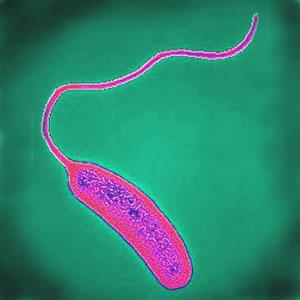Vibrio cholerae: curved rod with one flagellum (monotrich). It is a Gram-negative, facultatively anaerobic bacterium.
It belongs to the following taxonomic classes:
- Domain: Bacteria
- Phylum: Proteobacteria
- Class: Gammaproteobacteria
- Order: Vibrionales
- Family: Vibrionaceae
- Genus: Vibrio
Some strains of V. cholerae cause the disease cholera. Their pathogenicity genes code for proteins directly or indirectly involved in the virulence of the bacteria. During infection, V. cholerae secretes cholera toxin, a protein that causes profuse, watery diarrhea. Colonization of the small intestine also requires the toxin coregulated pilus (TCP), a thin, flexible, filamentous appendage on the surface of bacterial cells.
The main reservoirs of V. cholerae are people and aquatic sources such as brackish water and estuaries, often in association with copepods or other zooplankton, shellfish, and aquatic plants. Recent studies indicate that global warming creates a favourable environment for the bacteria.
Cholera is an acute intestinal infection causing profuse watery diarrhea, vomiting, circulatory collapse and shock. Many infections are milder diarrhea or are asymptomatic.
Cholera infections are most commonly acquired from drinking water in which V. cholerae is found naturally or into which it has been introduced from the feces of an infected person. Other common vehicles include contaminated fish and shellfish, produce, or leftover cooked grains that have not been properly reheated. Transmission from person to person, even to health care workers during epidemics, is rarely documented.
Cholera has been very rare in industrialized nations for the last 100 years; however, the disease is still common today in other parts of the world, including the Indian subcontinent and sub-Saharan Africa.
The disease is caused by toxigenic Vibrio cholerae O-group 1 or O-group 139. Only toxigenic strains of serogroups O1 and O139 have caused widespread epidemics and are reportable to the World Health Organization (WHO) as "cholera".
V. cholerae O1 has two biotypes, Classical and El Tor, and each biotype has two distinct serotypes, Inaba and Ogawa. The symptoms of infection are indistinguishable, although a higher proportion of persons infected with the El Tor biotype remains asymptomatic or have only a mild illness.
The WHO factsheet identifies the key facts on cholera:
- Cholera is an acute diarrhoeal disease that can kill within hours if left untreated.
- There are an estimated 3–5 million cholera cases and 100 000–120 000 deaths due to cholera every year.
- Up to 80% of cases can be successfully treated with oral rehydration salts.
- Effective control measures rely on prevention, preparedness and response.
- Provision of safe water and sanitation is critical in reducing the impact of cholera and other waterborne diseases.
- Oral cholera vaccines are considered an additional means to control cholera, but should not replace conventional control measures.
Although cholera can be life-threatening, it is easily prevented and treated. Prompt restoration of lost fluids and salts through rehydration therapy is the primary goal of treatment. Antibiotic treatment, which reduces fluid requirements and duration of illness, is indicated for severe cases of cholera. Zinc treatment has also been shown to help improve cholera symptoms in children.
http://en.wikipedia.org/wiki/Vibrio_cholerae
http://www.cdc.gov/cholera/index.html
http://www.cdc.gov/cholera/epi.html
http://www.who.int/mediacentre/factsheets/fs107/en/index.html
